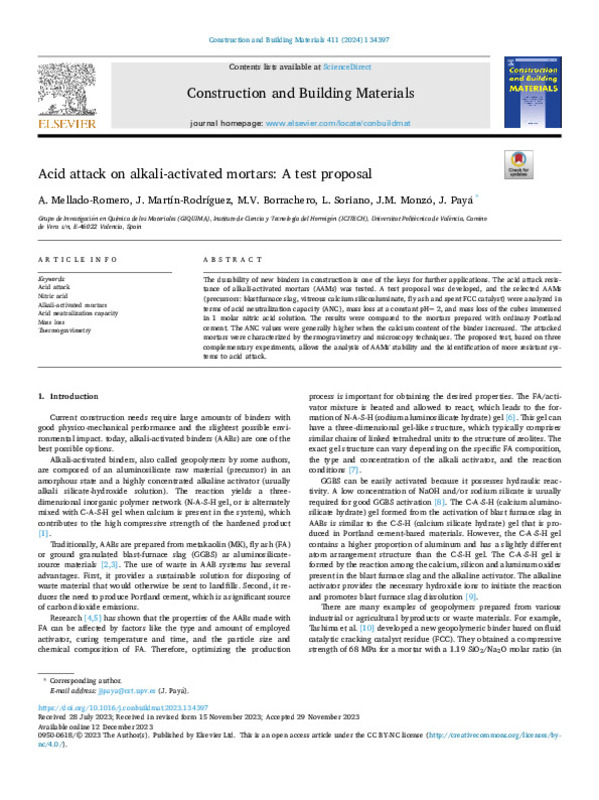JavaScript is disabled for your browser. Some features of this site may not work without it.
Buscar en RiuNet
Listar
Mi cuenta
Estadísticas
Ayuda RiuNet
Admin. UPV
Acid attack on alkali-activated mortars: A test proposal
Mostrar el registro sencillo del ítem
Ficheros en el ítem
| dc.contributor.author | Mellado Romero, Ana María
|
es_ES |
| dc.contributor.author | Martín-Rodríguez, J.
|
es_ES |
| dc.contributor.author | Borrachero Rosado, María Victoria
|
es_ES |
| dc.contributor.author | Soriano Martinez, Lourdes
|
es_ES |
| dc.contributor.author | Monzó Balbuena, José Mª
|
es_ES |
| dc.contributor.author | Paya Bernabeu, Jorge Juan
|
es_ES |
| dc.date.accessioned | 2024-04-25T18:08:26Z | |
| dc.date.available | 2024-04-25T18:08:26Z | |
| dc.date.issued | 2024-01-12 | es_ES |
| dc.identifier.issn | 0950-0618 | es_ES |
| dc.identifier.uri | http://hdl.handle.net/10251/203764 | |
| dc.description.abstract | [EN] The durability of new binders in construction is one of the keys for further applications. The acid attack resistance of alkali-activated mortars (AAMs) was tested. A test proposal was developed, and the selected AAMs (precursors: blastfurnace slag, vitreous calcium silicoaluminate, fly ash and spent FCC catalyst) were analyzed in terms of acid neutralization capacity (ANC), mass loss at a constant pH= 2, and mass loss of the cubes immersed in 1 molar nitric acid solution. The results were compared to the mortars prepared with ordinary Portland cement. The ANC values were generally higher when the calcium content of the binder increased. The attacked mortars were characterized by thermogravimetry and microscopy techniques. The proposed test, based on three complementary experiments, allows the analysis of AAMs ' stability and the identification of more resistant systems to acid attack. | es_ES |
| dc.description.sponsorship | The authors declare the following financial interests/personal relationships which may be considered as potential competing interests. Jordi Paya reports financial support was provided by Universitat Politecnica de Valencia. | es_ES |
| dc.language | Inglés | es_ES |
| dc.publisher | Elsevier | es_ES |
| dc.relation.ispartof | Construction and Building Materials | es_ES |
| dc.rights | Reconocimiento - No comercial (by-nc) | es_ES |
| dc.subject | Acid attack | es_ES |
| dc.subject | Nitric acid | es_ES |
| dc.subject | Alkali-activated mortars | es_ES |
| dc.subject | Acid neutralization capacity | es_ES |
| dc.subject | Mass loss | es_ES |
| dc.subject | Thermogravimetry | es_ES |
| dc.subject.classification | INGENIERIA DE LA CONSTRUCCION | es_ES |
| dc.title | Acid attack on alkali-activated mortars: A test proposal | es_ES |
| dc.type | Artículo | es_ES |
| dc.identifier.doi | 10.1016/j.conbuildmat.2023.134397 | es_ES |
| dc.rights.accessRights | Abierto | es_ES |
| dc.contributor.affiliation | Universitat Politècnica de València. Escuela Técnica Superior de Ingenieros de Caminos, Canales y Puertos - Escola Tècnica Superior d'Enginyers de Camins, Canals i Ports | es_ES |
| dc.description.bibliographicCitation | Mellado Romero, AM.; Martín-Rodríguez, J.; Borrachero Rosado, MV.; Soriano Martinez, L.; Monzó Balbuena, JM.; Paya Bernabeu, JJ. (2024). Acid attack on alkali-activated mortars: A test proposal. Construction and Building Materials. 411. https://doi.org/10.1016/j.conbuildmat.2023.134397 | es_ES |
| dc.description.accrualMethod | S | es_ES |
| dc.relation.publisherversion | https://doi.org/10.1016/j.conbuildmat.2023.134397 | es_ES |
| dc.type.version | info:eu-repo/semantics/publishedVersion | es_ES |
| dc.description.volume | 411 | es_ES |
| dc.relation.pasarela | S\513776 | es_ES |
| dc.contributor.funder | Universitat Politècnica de València | es_ES |








